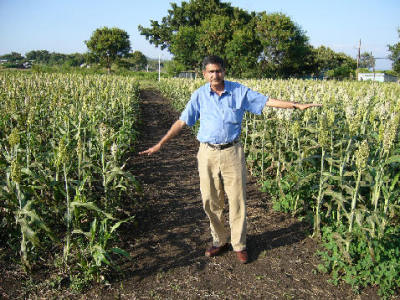
Grains in the chicken forest pasture
 In
addition to our grains for human consumption, I plan to incorporate
some grains into the non-forested part of our new chicken
forest
pasture. I'll
let the chickens scratch up one of the flat areas
well, then turn the birds into another paddock while I broadcast
buckwheat, millet, and perhaps corn seeds into the distressed
ground. After three months, I'll be able to rotate the chickens
which we plan to keep for the winter into the grain paddock so that
they can supplement their winter foraging with grains.
In
addition to our grains for human consumption, I plan to incorporate
some grains into the non-forested part of our new chicken
forest
pasture. I'll
let the chickens scratch up one of the flat areas
well, then turn the birds into another paddock while I broadcast
buckwheat, millet, and perhaps corn seeds into the distressed
ground. After three months, I'll be able to rotate the chickens
which we plan to keep for the winter into the grain paddock so that
they can supplement their winter foraging with grains.
I've already outlined
the method for growing
buckwheat and
everyone
knows how to grow corn. But how do you grow millet?
Unfortunately, several different species (each in their own genus, so
only vaguely related) are called by the name "millet" and each has its
own growing requirements. Pearl millet has the largest seeds
and the advantage of threshing free from its hulls naturally, but pearl
millet also requires warm
temperatures and may not set seed in cold climates. Proso millet
can be grown in cooler areas since it requires only 60 to 90 days to
mature, and Titus emailed me that her chickens adore the seeds so I
suspect the hull doesn't bother them. Have you grown millet in
your garden? If so, what kind, and how did it do?
| This post is part of our Homegrown Whole Grains lunchtime series.
Read all of the entries: |
Want more in-depth information? Browse through our books.
Or explore more posts by date or by subject.
About us: Anna Hess and Mark Hamilton spent over a decade living self-sufficiently in the mountains of Virginia before moving north to start over from scratch in the foothills of Ohio. They've experimented with permaculture, no-till gardening, trailersteading, home-based microbusinesses and much more, writing about their adventures in both blogs and books.
Want to be notified when new comments are posted on this page? Click on the RSS button after you add a comment to subscribe to the comment feed, or simply check the box beside "email replies to me" while writing your comment.

Daddy --- what were you growing millet for? (I hope you didn't tell me this already --- if so, I've forgotten. )
)
Brett --- I'd never heard of seed screenings. Very permaculture of you to have figured it out and gotten the free feed!